Weekend
3 round-up, 14-15 February 2015
by
John Saunders
Foggy Foggy Dew
|
 |
|
|
New 4NCL league venue, Holiday Inn,
Birmingham Airport |
|
|
|
|
February, and the third
4NCL weekend: a new venue beckoned, the
Holiday Inn, near Birmingham Airport,
roughly equidistant to the former Hinckley
Island location for those travelling from
north and south, but, on the day,
practically inaccessible for the latter.
Triskaidekaphobes might suspect the
influence of the previous day, Friday the
13th, which was a particularly foggy one for
those travelling to the venue overnight.
Anyway, the fog continued into the morning
of Saturday the 14th, and was the cause of
two major road accidents on motorways headed
north, leading to the closure of the
northbound M40 and M1 at key points. Yours
truly learnt of this via the car radio about
ten minutes into my own journey and decided
that, with two such important open files
duly blocked, the hour's contingency I had
built into my journey plan would be wholly
insufficient. The best strategy would be to
stay on the back rank (or rather, in my back
bedroom) and follow play from afar.
| |
 |
|
|
|
Those due to play had
to carry on regardless, of course, but
whatever contingency they had left for
travel on the day could never have been
enough in the circumstances and many players
arrived very late. Monitoring play on the 32
live boards, there were still about 12 games
where at least one of the players had not
started the game after around 40-45 minutes.
The Hackney team's moves only started
appearing on the board after around 45
minutes had elapsed. The arbiters had long
since ruled that the normal default time of
one hour should be waived, and left it to
captains to negotiate with each other and do
the decent thing in the circumstances. Which
they did: my understanding is that, amongst
others, e2e4.org.uk, relatively unaffected
by the traffic chaos, graciously offered
fellow relegation strugglers Hackney an
equal time deal to start their match. Good
on them: in Britain we're not at home to Mr
Zero Tolerance, which we see as a
thinly-disguised euphemism for intolerance,
which is something we find intolerable. A
bit self-contradictory, perhaps, but there
you are...
Wood Green HK 4˝-3 The
ADs; Blackthorne Russia 4˝-3˝ White Rose;
Guildford 2 5˝-2˝ South Wales Dragons;
Warwickshire Select 2˝-5˝ Barbican 1
|
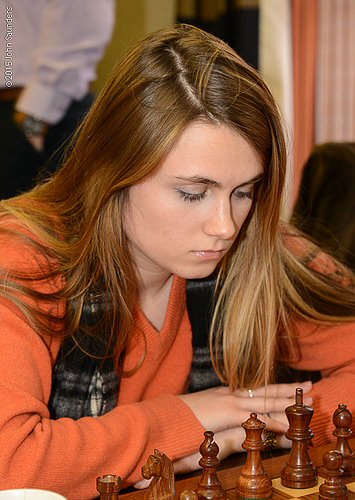 |
|
Anna York-Andersen (Hackney) |
Wood Green, once again
labouring under the handicap of being a
player short, nevertheless won rather
comfortably, with their top boards
performing well. Neil McDonald was one
casualty, coming unstuck against Darren
Wheeler's French Defence, and Sarah Hegarty
another, with a Giuoco which was a bit too
Pianissimo for comfort against Jonathan
Swindells. Malcolm Pein played a sprightly
Benoni.
4NCL 2014/15, Division 1a, Round 5
David Anderton
(The ADs)
Malcolm
Pein (Wood Green)
1.d4 Nf6 2.c4 c5 3.d5 d6 4.Nc3 g6 5.g3 Bg7
6.Bg2 0‑0
7.Nf3 Na6 8.0‑0
Nc7 9.a4 Rb8 10.h3 e6 11.e4 exd5 12.cxd5 Re8
13.Re1 a6 14.a5
14.Bf4 may be a bit more accurate here.
14...Nb5 Undermining the defence of e4.
15.e5 dxe5 16.Rxe5?! 16.Nxe5 keeps
the ship steady, although Black has
equalised after 16...Nd6 16...Nxc3
17.bxc3
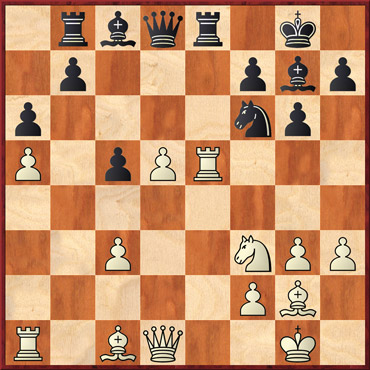
17...Ne4!
This wins the c3–pawn, though White can
maybe hope to get a tiny bit of play for it.
18.Rxe8+ Qxe8 19.Bd2? 19.Bf4! Nxc3
20.Qe1! is tricky, e.g. 20...Ne2+ 21.Kf1 Bd7
22.Bxb8 Bb5 23.Bc7 Nc1+ 24.Kg1 Qxe1+ 25.Nxe1
Bxa1 26.d6 and, rather unjustly, White seems
to be escaping the consequences of his
previous sins. I wouldn't
fancy having to calculate all that at the
board, however. 19...Nxc3 20.Bxc3 Bxc3
21.Ra3 Bf6 22.Nd2 Bd7 23.Ne4 Bd4 24.Qf3?
White's
last outside chance was 24.Qxd4!? cxd4
25.Nf6+ Kf8 26.Nxe8 Rxe8 27.Rd3 when he's
a pawn down but not completely dead.
24...f5 25.Nd6 Qe1+ 26.Bf1 b5! 27.Ra2
Black's
last move cuts off the knight's
only safe retreat, but if 27.axb6 Rxb6
28.Nc4 Rb1 he's
being mullered on the back rank. 27...Qe5
28.Qf4 Qxf4 29.gxf4 c4
0‑1
Getting ready to perform the last rites on
the knight with Bc5.
Blackthorne Russia beat
White Rose by the odd point, which was a
major set-back for the Yorkshire side, who
had led the pool at the end of the second
weekend. This match featured some very
good-looking chess on boards one and two,
where Adam Hunt beat Peter Wells, and James
Adair beat Danny Gormally, and a couple of
rollicking tactical encounters in which
Richard Bates beat Ian Gourlay and Laurence
Webb overcame Colin McNab. I recommend
playing through all four of these games but
I shall only feature one here. The chess
analysis engine makes fools of us all so I
hope the two gentlemen who played this game
will forgive me for pointing out their human
failings.
4NCL 2014/15, Division 1a, Round 5
Richard Bates
(Blackthorne Russia)
Iain Gourlay
(White Rose)
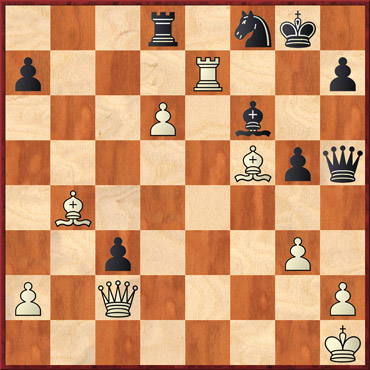
After many adventures, in which the
advantage had swung wildly first one way and
then the other, the players arrived here
with White to play. 47.Qb3+? The
important thing for White to do here is to
make sure Black can't
play Qd1+ or Qf3+ followed by Bd4+. One good
move is 47.Qd3! since he doesn't
have to bother about 47...Bxe7 48.dxe7 Rxd3
as 49.exf8 is mate. Also, the attempt at
deflection with 47...c2 fails to 48.Qd5+ Kh8
49.Bxc2 and everything is nicely covered.
Alternatively, 47.Kg2 is not so fancy but
wins just as effectively. But White is under
the illusion that he has a direct way to
finish the game... 47...Kh8 48.Qxc3?
Rxd6! Putting a stop to White's
fantasy, which was no doubt 48...Bxc3??
49.Bxc3+ Kg8 50.Rg7+ Kh8 51.Rxg5 mate.
49.g4 Qh6 50.Qe3? Bxe7? This should be
good enough to draw, but Black has a
probable win after 50...Rd1+ 51.Kg2 Bd4!
when 52.Bc3 fails to 52...Qc6+, etc.
51.Qxe7 Rd1+ 52.Kg2 Rc1?? 52...Kg8!
holds, though it's
not quite as obvious as it looks. Black
probably feared the consequence of 53.Bc2
but Black has 53...Qc6+ 54.Be4 and now
54...Qc8! when White can't
quite conjure up a killer move with his
light-squared
bishop, and 55.Qxg5+ Ng6 keeps White at bay.
53.Qxf8+ Qxf8 54.Bxf8 and now White
won uninterestingly... 54...Rd1 55.Be7 h6
56.Bf8 Rd2+ 57.Kg3 Rxa2 58.Bxh6 Ra3+ 59.Kg2
Ra2+ 60.Kf3 Rxh2 61.Bxg5 a5 62.Bf6+ Kg8
63.g5 1‑0
|
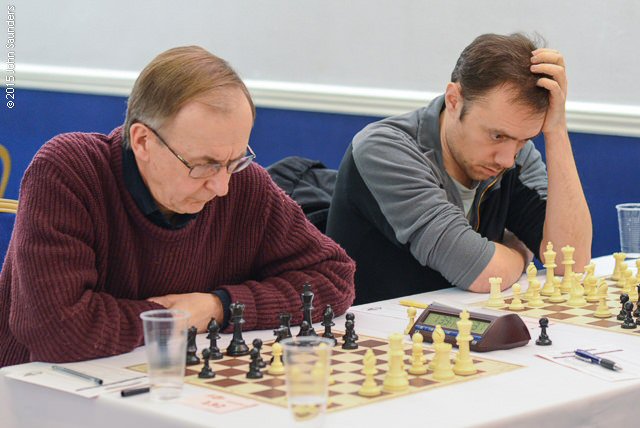 |
|
John Cooper, James Cobb (South
Wales Dragons) |
Guildford 2 won
comfortably enough against South Wales
Dragons but the only game of interest was
the one which their top board Nick Pert lost
to James Cobb. A Nick Pert loss with White
is a very unusual occurrence, as
acknowledged by Guildford supremo Roger
Emerson after the match. Actually, board two
was also quite interesting, with John Cooper
having a markedly superior position when
Aussie GM David Smerdon offered him a draw.
No doubt John was in time trouble, however,
so a half point in the hand might have been
better than a full one in the Australian
bush. Let's look at James Cobb's win.
4NCL 2014/15, Division 1a, Round 5
Nick Pert
(Guildford 2)
James
Cobb
(South Wales Dragons)
1.d4 Nf6 2.Nf3 e6 3.c4 d5 4.Nc3 Nbd7 5.cxd5
The exchange rate in the Queen's
Gambit is much higher than it was in the old
days (when you could get more for your
pounds, shillings and pence, too). Perhaps
players these days seem to think they can
obtain a significant edge by an early
exchange on d5. 5...exd5 6.Bf4 c6 7.e3
Nh5 8.Be5 Not the main line, which is
8.Bg5 Be7 9.Bxe7 Qxe7 10.Qc2, etc.
8...Nxe5 9.Nxe5 Nf6 10.Bd3 Bd6 11.f4 My
database has precisely two games with this
line. One, a game between Vadim Alekseev and
Gennadi Kuzmin in 1999 (draw) and, two,
Alekhine against somebody in a simul in
Cleveland in 1924, which the future world
champion lost. 11...0‑0
12.0‑0
c5 13.Qf3 cxd4 14.exd4 Qb6 15.Qf2 Bb4
16.Rae1 Qa5 17.Re3 Bxc3 18.bxc3 Ne4
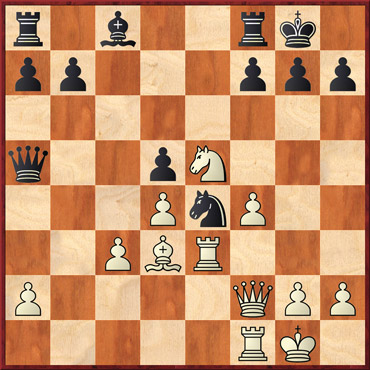
19.Qh4?
White goes all out for the attack, but it
turns out badly. 19.Qe1! is Houdini's
suggestion and it looks useful. If 19...f5!?
(All three pawn grabs are disastrous:
19...Qxc3?? 20.Rxe4 wins; 19...Nxc3?? 20.Bc2
wins a piece; 19...Qxa2? 20.f5! and White's
attack looks unstoppable.) 20.c4! Qxe1
21.Rfxe1 Be6 22.c5 White has the edge.
19...Qxc3 20.f5 20.Qxh7+!? Kxh7 21.Bxe4+
dxe4 22.Rxc3 looks OK at first sight but
22...f6! 23.Nc4 Rd8! is a bit tricky, e.g.
24.Rd1 Bg4 25.Rd2 Rac8 and Black is
definitely better. 20...Qxd4 21.Ng4 f6
22.Kh1 Qc5 Typically, the engine finds
something clever: 22...Kh8! when 23.Bxe4
dxe4 24.Rh3 is answered by 24...Bxf5! The
usual stricture applies: most humans would
be reluctant to trust their calculations to
risk this. 23.Qh5 Ng5 24.h4 Kicking
the knight with the h-pawn
is all very well but it means that a future
Rh3 will no longer support a queen attack on
h7. Instead, 24.Rg3!? Qe7 25.Ne3 keeps the
tactical pot bubbling a bit longer.
24...Ne4 25.Bxe4 dxe4 26.Rg3 Kh8 27.Ne3 Bd7
28.Qg4 Rf7 29.h5 29.Qxe4 Re7 30.Qg4 Bc6
doesn't
look any better. 29...h6 30.Qf4 Qe5
Black decides to cash in one of his extra
pawns to liquidate. It turns out well for
him. 31.Qxe5 31.Qg4 keeps the queens
on but impedes White still further.
31...fxe5 32.Rg4 Raf8 33.Rxe4 Bxf5 34.Rxe5
Bd7 35.Rd1 Better to exchange off a pair
of rooks with 35.Rxf7 Rxf7 36.Kg1 but after
36...Rf4 37.Re7 Bc6 things still look pretty
grim for White. 35...Bc6 36.Kg1 Rf2 37.a3
Re2 38.Rf1 Rxf1+ 39.Kxf1 Ra2 40.Re7 Rxa3
41.g4 41.Nf5 Ra1+ 42.Kf2 Ra2+ 43.Ke3
Rxg2 is hopeless. 41...Ra4 42.Ke2 Rf4
43.Rc7 a5 44.Kd3 a4 45.Nf5 Rxg4 46.Ne7 Be4+
47.Ke3 Kh7 48.Rc8 a3 49.Ra8 Bc2 50.Kd2 Ra4
51.Rf8 a2 52.Ng6 Not the subtlest of
last-try
cheapos... 52...Bxg6
0‑1
Warwickshire Select
aren't having the easiest of seasons and
they only came away with a couple of points
against Barbican 1. Geoff Lawton is having a
nightmare season. This was his fifth
straight loss in this year's 4NCL (and it
became 0/6 after his Sunday game). The Ruy
Lopez is often nicknamed ‘the Spanish
Torture' but I'm pretty sure White is
supposed to be Torquemada and Black the
Inquisition victim. Not here...
|
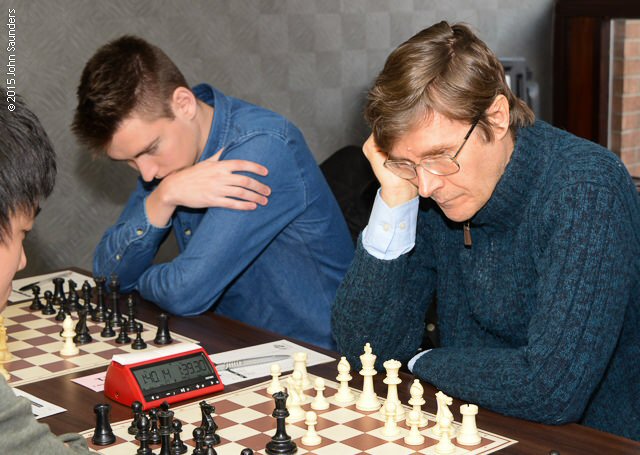 |
|
Richard Weaving, Geoff Lawton
(Warwickshire Select) |
4NCL 2014/15, Division 1a, Round 5
Geoff Lawton
(Warwickshire Select)
Sam
Collins
(Barbican 1)
1.e4 e5 2.Nf3 Nc6 3.Bb5 a6 4.Ba4 Nf6 5.0‑0
Be7 6.Re1 b5 7.Bb3 0‑0
8.d3 d6 9.c3 Na5 10.Bc2 c5 11.d4
Taking two moves to reach d4. The loss of a
tempo doesn't
always matter quite as much as it seems to
here. 11...Qc7 12.Nbd2 This was White's
last chance to close the queenside with
12.d5 and he's
made to regret the omission. 12...cxd4
13.cxd4 Nc6 14.d5 Nb4 15.Bb1 a5 16.a3
Weakening the b3 square. Maybe 16.Nf1 Bd7
17.Bd2 Na6 18.h3 Rfc8 19.Ng3 Nc5 is
preferable, but White remains very passive.
16...Na6 17.Nf1 Nc5 18.Bd2 a4 19.Bb4 Qa7
20.N3d2 Bg4! 21.Qc1 Chucking in 21.Bxc5
Qxc5 and then playing 22.Nf3 isn't
great but could be better than having the
queen forced to the uncomfortable c-file.
21...Rac8 22.Bc3 Bd8 23.Ne3 Ba5 24.Bc2
Rc7 25.Qb1 Rfc8 26.Bd1 Bd7 27.Be2 27.Bf3
is the best grovel Houdini can come up with,
when 27...Bxc3 28.bxc3 Na6 29.Nd1 is not as
bad as it looks. 27...g6 28.Nd1 Bb6
29.Ne3? Worn down by the incessant
pressure, White blunders. 29...Nb3!
0‑1
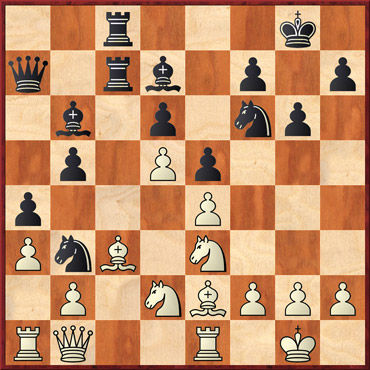
Having spent the best part of twenty years
of my chess career grovelling around on the
back two ranks in positions like this, I
feel I can truly empathise with White's
plight here. I'd
imagine myself thinking, thus: “I
could play 30.Nxb3 (or maybe 30.Bd3, oh, but
Black's
got 30...Rxc3!) but then he's
got 30...Bxe3 31.fxe3 Qxe3+ 32.Kh1 Nxe4 ...
you know what? To hell with it: why don't
I just resign and go to the bar?”
Cambridge University
˝-7˝ Guildford 1; Cheddleton 6-2 Barbican 2;
Oxford 5-3 Grantham Sharks; e2e4.org.uk 4-4
Hackney
Cambridge University
received a fearful tonking from a full
strength Guildford 1 team, but the Light
Blues could count themselves just a tad
unfortunate. For one thing, one of their
number was absent, presumably in a traffic
jam, leaving Matthew Sadler with nothing to
do but watch his absent opponent's time tick
away. For another, even their loyal
manager/sponsor Roger Emerson admitted that
the final score was “incredibly flattering”.
The Guildford's various opening sequences
didn't look all that convincing, apart from
Romain Edouard, who indulged in a
theoretical duel with Ravi Haria. Romain
does this sort of thing regularly: only a
few days ago in Gibraltar I saw him play a
surreal line in the Queen's Gambit where
Black holds onto the gambit pawn like grim
death and then gives up the exchange very
early. That game brought him the Tradewise
Gibraltar best game prize, and incidentally
the same line was used by tournament winner
Hikaru Nakamura to win an early game in the
same event. Here Romain is on the White side
of a QGD and breathing fresh life into the
Ragozin line.
4NCL 2014/15, Division 1b, Round 5
Romain Edouard
(Guildford 1)
Ravi Haria
(Cambridge University)
1.d4 e6 2.c4 d5 3.Nc3 Nf6 4.Nf3 Bb4 5.cxd5
exd5 6.Bg5 Nbd7 7.Rc1
7.e3 and 7.Qc2 have been played more often
but this is becoming trendy, having been
played by Carlsen amongst others. 7...0‑0
8.e3 c5 9.dxc5 Qa5 10.a3!?
A bold move, entailing an exchange
sacrifice. 10.Nd2 is answered by 10...b6,
but has scored poorly in practice.
10...Bxc3+ 11.Rxc3 Ne4 12.b4 Nxc3 13.Qa1 Qa4
14.Qxc3 a5 15.b5
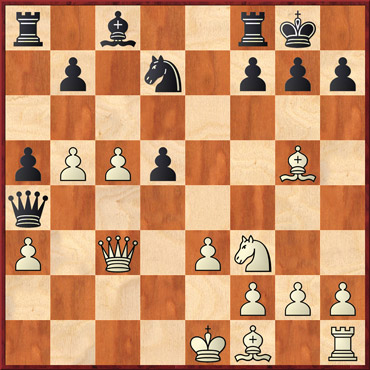
White has a pawn for the exchange, the black
queen is caught behind enemy lines and the
black pieces are struggling to develop.
However, White has a few problems, too: his
king badly needs to escape the scene as he
is vulnerable to a knight sac on c5,
followed by a heavy piece invasion via the
opened c-file.
In practice, however, Black has yet to make
this idea work and White has scored
overwhelmingly. 15...h6 Carlsen tried
the immediate 15...Nxc5 against Topalov at
Wijk aan Zee in 2007, but after 16.Qxc5 Be6?
(16...Bd7, keeping pressure on b5, was
identified by Topalov as a better move)
17.Qc1! Rfc8 18.Qa1 Qc2 19.Be2 Qc1+ 20.Qxc1
Rxc1+ 21.Bd1 Ra1 22.a4 Rc8 23.Nd4 Rc4 24.0‑0
f6 25.Bf4 Bf7 26.h4, Black decided he didn't
have enough for his material and resigned.
16.Bf4 Nf6 17.Nd4 Ne4 18.Qc1 Bd7 19.f3
Nxc5!? Houdini rejects this out of hand,
suggesting 19...Ng5 is best, but after
20.Bxg5 hxg5 21.Bd3 Rfe8 22.Kf2, Black is
being systematically shut out of the game,
with little realistic chance of counterplay.
20.Qxc5 Rfc8 21.Bc7 21.Qxd5 Rc1+
22.Kf2 Qd1 23.g4 g5! would be a very tricky
line to calculate, with any slight mistake
being fatal. 21...b6 22.Qxd5 22.Qxb6?
allows 22...Qxa3, threatening Qc3+/Qxc7, and
Qxe3+. Houdini analyses 22.Qd6 Ra7 23.Bxb6
Rc1+ 24.Kf2 Qd1 out to a win for White but
the text is perhaps more sensible, requiring
slightly less rigorous calculation.
22...Qxa3 23.Kf2 Qc1? White wraps things
up quickly after this. 23...Qc5! 24.Qxd7
(24.Qxc5 bxc5 25.b6 Rxc7 26.bxc7 cxd4 is not
so clear) 24...Rxc7 25.Qg4 is by no means
completely winning but probably offers
enough advantage to satisfy a GM playing a
much lower-rated
player. 24.Bc4 Qxh1 After 24...Qd2+
White goes into reverse with 25.Be2, content
simply to menace the d7–bishop and then
swing his rook into play. 25.Qxf7+ Kh8
26.Be5 Rg8 27.Qg6 1‑0
|
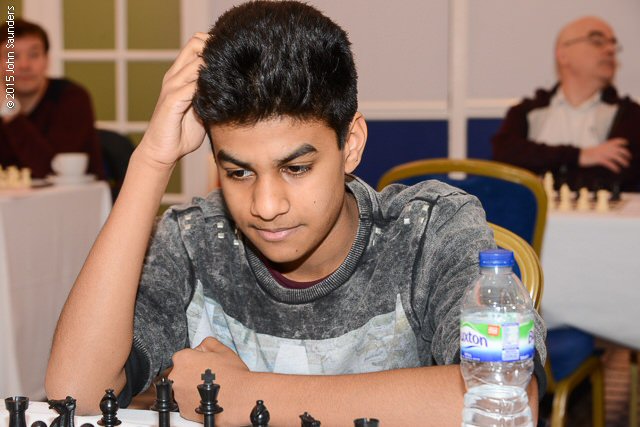 |
|
Ravi Haria (Cambridge University) |
John-Paul Wallace's
opening didn't look too bad but then his
minor pieces got into a tangle and that was
pretty much all Gawain Jones needed to take
over the initiative and barge him off the
board. Reminded me a bit of a rugby match.
That may not be a coincidence as I think
Gawain did used to play rugby, and only a
month or two back he partnered former
England rugby manager Sir Clive Woodward in
a pro-am chess event at the London Classic.
And his wife Sue is a Kiwi and a rugby
player herself. Just checking my facts on
this, I headed over to Gawain's blog
(gawainjones.co.uk) and discovered that the
last post there was entitled ‘Rugby Mania'.
My case rests... well, it will do as soon as
I can think of a suitable pun to go with it
(as Gawain really likes my puns. Or really
hates them. Can't remember which but it was
definitely one or the other.) White starts
well enough, but it's not long before All
Black's pieces push him off the board (good
enough? Please yourselves).
4NCL 2014/15, Division 1b, Round 5
John-Paul Wallace
(Cambridge University)
Gawain Jones
(Guildford 1)
1.d4 Nf6 2.c4 e6 3.Nc3 Bb4 4.e3 0‑0
5.Bd3 d5 6.cxd5 exd5 7.Nge2 Bd6
7...Re8 is the routine move but the text is
quite trendy. If White chases the bishop
with the knight, it retreats and Black then
chases the knight with a pawn -
or ‘knock
for knock',
as car insurers like to say. 8.Bd2 Re8
9.Rc1 Na6 New, I think. Black supports
the c7–c5 push and is not bothered about
getting doubled a-pawns
since White's
resultant light squares will be weakened if
the bishop disappears. 10.a3 c5 11.Nb5
Bf8 12.dxc5 Nxc5 13.Bb4 b6! After
13...Nxd3+ 14.Qxd3 Bxb4+ 15.axb4, White has
a slight edge based on good control of the
dark squares, but the text keeps things more
edgy. 14.Ned4? White gets into
trouble after this. Instead 14.0‑0
leaves him slightly worse but perhaps not
seriously so. 14...a6 15.Nc3 a5 16.Bxc5
bxc5 17.Nde2 He has to go back here
otherwise ...d5–d4 is even more unpleasant.
17...Bb7 18.0‑0
Rc8
Black now has a reasonable advantage with
his two bishops, secure centre and active
piece play. 19.Bf5 Rc6 20.Qa4 Rb6!
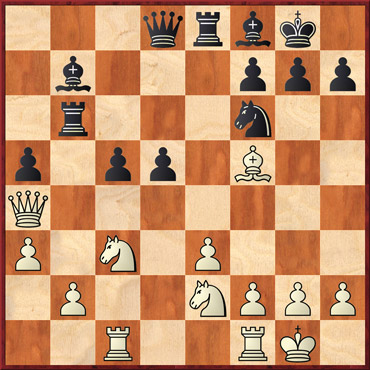
21.Qc2?
I expect many of us would have taken our
chances with 21.Qxa5 Rxb2 22.Qxd8 Rxd8
23.Rb1 Rxb1 24.Rxb1 Ba6 but it's
the sort of position with a strong
initiative which super-GMs
tend to win at a canter. That said, it's
better than the game line, where Black has a
more or less forced sequence leading to a
win. 21...g6! 22.Bh3 22.Bd3 c4 traps
the bishop. 22.Na4!? is the best of a bad
job but 22...gxf5 23.Nxb6 Qxb6 24.Qxf5 Ba6
25.Rfe1 Qxb2 leaves Black with two bishops
for a rook. 22...d4! The start of a
powerful loose ruck. The threat to the
knight and the fork with d3 are pretty
obvious, but it goes further than that.
23.Rfd1 Rd6 24.Qb3 dxc3 25.Rxd6 Qxd6 26.Qxb7
Rb8 26...Qd2 also scores a try but the
text makes sure of a conversion. 27.Qa7
cxb2 28.Rb1 Qd3
0‑1
On other boards, the
lesser lights seemed to be doing well,
particularly Sabrina Chevannes, who at one
stage looked to be in with a very good
chance of downing former women's world
champion Antoaneta Stefanova. But eventually
the dead hand of the rating list came to
bear on all boards, except on board five
where Adam Bukojemski had the better of a
draw, having forced GM Maxime Lagarde to
give up the exchange so as not to be mated.
Might be worth playing through that game if
there isn't enough chess for you here
already.
|
 |
|
Gawain Jones (Guildford 1) |
Cheddleton warmed up
for their big match with the favourites on
the Sunday by dispatching Barbican 2. Four
white wins and four black draws made it look
like a well-ordered plan but it was hardly
that. John Pitcher scored a consolation
point for the underdogs, beating IM Lorin
D'Costa. Jonathan Rogers and Keith Arkell
had an eventful game featuring some
spectacular oversights. I am very grateful
to Keith Arkell for explaining how he came
to miss a crunching winner in this game, and
for being typically affable in discussing it
with me and other players on Facebook (not
for nothing is he the current English Player
of the Year). I've built Keith's comments
into my annotation. It's a fascinating
deconstruction of what goes on in a GM's
mind when planning several moves ahead in a
complicated position, and also a cautionary
tale highlighting the importance of
re-evaluating a position which you had
previously envisaged in your mind when it
eventually appears on the board.
4NCL 2014/15, Division 1b, Round 5
Jonathan Rogers
(Barbican 2)
Keith
Arkell
(Cheddleton)
1.e4 c6 2.d4 d5 3.e5 c5 4.c4 e6 5.Nf3 cxd4
6.Nxd4 Bb4+!?
Databases are peppered with games where
Keith has played 6...Nc6 but perhaps he
wanted to keep his opponent guessing.
7.Nc3 Ne7 8.h4 Nbc6 9.a3!? Jonathan,
perhaps with the far-sighted
plan of not being strangled slowly in a rook
and pawn endgame, wants to provoke something
sharp. 9...Bxc3+ 10.bxc3 Nxe5 11.Bf4 N5g6
11...Nxc4 12.Bxc4 dxc4 is tempting but
maybe 13.Nb5 0‑0
14.Qxd8 Rxd8 15.Nc7 Nd5 16.0‑0‑0!?
gives White a bit of compensation. Instead,
Black gives back material to get some
pressure on the e-file.
12.Bg3 e5 13.h5 exd4 14.hxg6 Nxg6 15.Qxd4
0‑0
16.cxd5 Re8+ 17.Be2 Ne7 18.Rd1 Nf5 19.Qd3
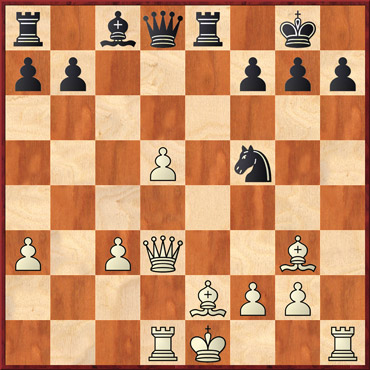
19...Qg5
We haven't
quite got there yet, but we're
coming up to a spectacular mutual oversight
which needs explaining. Seeking
enlightenment (and also wanting to be sure
that the moves were correctly recorded
–
mix-ups
do happen), I got in touch with Keith on
Facebook to ask what happened. Keith
responded at some length, centring on his
thoughts as he planned the move 19...Qg5.
What followed are his own words, lightly
edited by me:
“It's
impossible to fully explain how such a thing
can happen, but let me try anyway.”
“So,
I'm
sitting there analysing the move I want to
play in principle -
which at the time was 19...Qd8–g5. I know
that my advantage increases if I can make
the move, but obviously I am concerned about
his possible reply 20.Qb5 So I analyse
20...Re4 (other moves didn't
look very good to me) 21.d6 -
the only move that could give me any
problem, as it threatens to win a piece.
Visualising the position, I then hoped that
21...Be6 would be strong, as it threatened
the winning 22...Bc4. Of course, the main
potential drawback to this is that he can
then fork my rooks with 22.Qxb7 I would then
need 22...Rxe2+ to work or I would be lost!
So -
and don't
forget, all this is before playing 19...Qg5
-
I set about analysing 22...Rxe2+ as I
(wrongly!) believed that 19...Qg5 hinged on
this. So, 22...Rxe2+ 23.Kxe2 Bc4+ 24.Kf3
(obviously forced) and then, I thought,
‘‘please
let 24...Re8 be a winning move''!
It certainly looked winning. It was obvious
he had to either put a rook on e1 or his
bishop on e5 to stop ...Be2 mate. I didn't
look beyond 24...Re8 ...
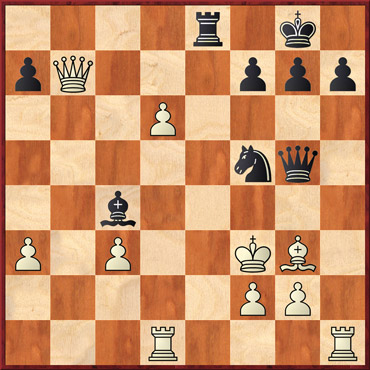
“25.Rde1
(I saw a pretty mate against 25.Rhe1 which
was 25...Qh5+ 26.Kf4 g5+ (my favourite
move!) 27.Kxf5 Qg6+ 28.Kg4 f5+ 29.Kh3 Qh5+
30.Bh4 Qxh4 mate, so that just left the
irritating 25.Be5 to deal with. Find a good
move there and I could play 19...Qg5. I
decided that 25...h5 must be winning and
anyway certainly left him in trouble.)
25...Bd5+ 26.Qxd5 Nh4+ winning.”
“So
I analysed no more and plunged in with
19...Qg5. He quickly replied 20 Qb5 and,
after briefly running through all those nice
lines again, I confidently played 20...Re4.
He continued following my analysis, with
21 d6?? and I had 21...Be6?? ready for him.”
“So
there you have it. The explanation is that
we were playing out a variation I had
analysed way ahead, and I didn't
stop properly to check if there might be
something else going on!”
20.Qb5 Re4 21.d6??
21.0‑0
Nxg3 22.fxg3 Re5!? seems to be broadly
equal. 21...Be6?? What Keith had
missed in his move 19 analysis, and what
Jonathan also missed when playing 21.d6, was
the bone-crushing
21...Nxg3!!, which is game over as 22.Qxg5
allows 22...Rxe2 mate, while a capture on g3
loses the queen to 22...Qxb5 as the e2
bishop is pinned. 22.Qd3?? 22.0‑0!
Rd8 23.Bd3 and White is well in the game.
22...Nxg3 This time Black doesn't
fluff his lines. 23.fxg3 Qe5! 24.Rh4
24.d7 Rd8 makes no material difference,
while a king move such as 24.Kf1 loses to
24...Bc4. 24...Bg4 25.Qxe4! A much
better bet than 25.Rxg4 Rxg4, which looks
pretty hopeless for White. 25...Qxe4
26.Rxg4 Qe5?! There seems to be no
reason not to snatch a pawn with 26...Qxg2
27.d7 Rd8, with very reasonable winning
chances. 27.d7 Qxc3+? After this,
Black's
winning chances evaporate. 27...Rd8 keeps
the Black flag flying, though it's
by no means obvious how he can go about
winning. 28.Kf1 Rd8 29.Re4! White's
firm control of the e-file
is his salvation. 29...Qc6 Possibly
another oversight, but it turns out to be
non-critical
as the following tactical sequence doesn't
leave Black too much to do to save the game.
After 29...Kf8 30.Bb5 Qf6+ 31.Ke1 g6 32.Re8+
Kg7 33.Rxd8 Qxd8 34.Rc1, the game peters out
to a draw. 30.Re8+ Rxe8 31.d8Q g6 32.Qd5
Qc3 33.Bc4 Qf6+ 34.Kg1 Re7 35.Rf1 Qb6+
36.Kh1 Qc7 The zenith of White's
game -
Houdini scores it at +2.13 -
but it is hard to see how White can bring
any more pressure to bear on Black's
position or make meaningful progress. Maybe
Magnus Carlsen would have found a way.
37.Qd4 a6 38.Rd1 b5 39.Bf1 Re8 40.Kh2 Qc2
41.Qd3 Qc5 ˝‑˝
|
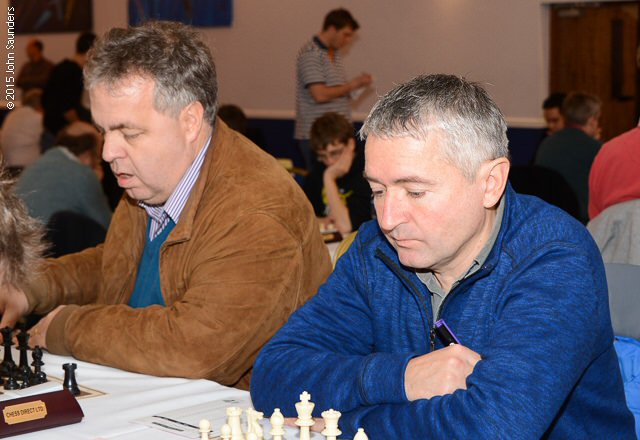 |
|
Neil Dickenson, Matthew Rose
(Oxford) |
Oxford and Grantham
Sharks are the main rivals for third spot in
the pool behind Guildford 1 and Cheddleton,
so Oxford did themselves a big favour by
winning this match. They needed a slice or
two of luck along the way, although it
wasn't apparent in this game.
4NCL 2014/15, Division 1b, Round 5
Peter Roberson
(Grantham Sharks)
Matthew
Rose
(Oxford)
1.e4 c5 2.c3 Nf6 3.e5 Nd5 4.Nf3
I always used to punt 4.d4 in my c3 Sicilian
days but this alternative has quite a lot
going for it. 4...Nc6 5.Bc4 Nb6 6.Bb3 d6
6...c4 7.Bc2 Qc7 8.Qe2 g5!? is one
reason I shied away from 4.Nf3. As Corporal
Jones might have said, had he been a chess
player: “c3
Sicilian players don't
like it up ‘em
-
the cold steel of ...g7–g5!”
7.exd6 e6 7...Qxd6 8.0‑0
Be6 gets a fair bit of traffic, but Black
decides to steer down a side road. 8.d4
cxd4 9.cxd4 Bxd6 10.0‑0
0‑0
11.Nc3 Nd5 12.Re1 Be7 13.Bc2 g6?!
There doesn't
seem to be any need to weaken the kingside
in this way, or at least not yet. 14.Bh6
Re8 15.Qe2 Qb6 16.Bb3! Nxc3 16...Nxd4
17.Nxd4 Qxd4 18.Bxd5 exd5 19.Rad1 looks
risky but 19...Qh4 20.Nxd5 Be6!? might be
playable. 17.bxc3 Bd7 18.d5 exd5 19.Bxd5
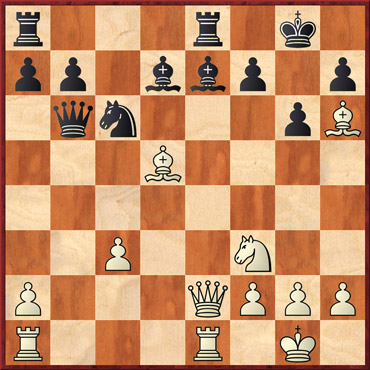
With all White's
pieces now poised to strike, Black can't
afford an inaccuracy. 19...Qc5?
19...Bf6! was the last chance: 20.Qc4 Rxe1+
21.Rxe1 Nd8 clings on, though 22.Qf4 Bg7
23.Ne5 Bxh6 24.Qxh6 Qd6 25.c4 is still very
promising for White. 20.Rad1 Rad8
20...Bf5 21.c4 gives White the choice of Ne5
and Qb2 as winning moves on the next turn.
20...Bd6!? at least forces White to find
some precise moves: 21.Be3! Qxc3 22.Bb3 Qf6
23.Qc4! Re7 (Otherwise Rxd6 wins) 24.Qd5!
and something has to give. 21.Bxf7+! Kxf7
22.Rxd7! 1‑0
Capturing the rook allows mate in one, while
22...Rf8 23.Qe6+ Ke8 24.Red1 is the simplest
way to win.
The 17-year-old
Portuguese FM David Pires Tavares Martins
gave his team a big morale booster with this
win against Ameet Ghasi, who must have been
ruing his makeshift opening play.
4NCL 2014/15, Division 1b, Round 5
David Martins
(Oxford)
Ameet
Ghasi
(Grantham Sharks)
1.d4 Nf6 2.Bg5 Ne4 3.Bf4 d6 4.Nd2 Bf5 5.Nxe4
Bxe4 6.f3 Bg6 7.e4 e6 8.Qd2 d5 9.Bd3 c5?!
Curiously, though Houdini places this as
fourth choice after Nc6, Qd7 and Be7, it is
not too critical of this move. Personally I'd
hate having to play Ke7, blocking the f8
bishop and exposing the king to possible
risk so early in the game. 10.Bxb8 Rxb8
10...Qxb8 11.Bb5+ Kd8 12.exd5 is visibly
worse along the d-file.
11.Bb5+ Ke7 12.dxc5
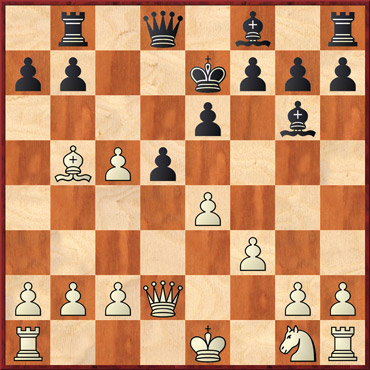
12...dxe4?
This is the definitive error. Instead,
12...a6! and now if 13.Ba4 (13.Bd3 might be
better) 13...dxe4 14.Qc3 Qc7 15.0‑0‑0,
Black has time for 15...b5! and Black is in
no immediate danger. Indeed, after 16.Bb3
Ke8! 17.fxe4 Qxc5 18.Qd2 Be7 Black may even
be a bit better. 13.Qc3 Qc7 14.0‑0‑0
Rd8
No time for 14...Qf4+ 15.Kb1 Rd8 as after
16.Rxd8 Kxd8 17.Qd4+ the black king will be
driven out into the centre via f6 and has no
chance of survival. 15.Ne2 a6 16.Ba4 f6
Black is desperate to find a square for
his king but it's
already too late. 17.c6! The computer
has still more diabolical tricks up its
sleeve but this will do nicely. 17...bxc6
17...b5 18.Bb3 Be8 19.Rxd8 Kxd8 20.Nd4
Kc8 21.Rd1 is an easy win. 18.Bxc6 exf3
19.Qc5+ Kf7 19...Rd6 20.Rxd6 Qxd6
21.Qa7+ Kd8 22.Rd1 is curtains. 20.Be8+
Rxe8 21.Qxc7+ and Black could have saved
himself further pain by resigning now
instead of playing on to move 39...
1‑0
Hackney, if you recall,
arrived very late for their match with
e2e4.org.uk but they were graciously allowed
to share the residual time with their
opponents and the result was an honourable
4-4 draw. There were the usual swings and
roundabouts, with e2e4's Jack Rudd's
overlooking a pawn en prise while the same
team's Alan Byron getting let off with a
draw in what looks like a horribly lost
position. Maybe the weekend came too soon
after a gruelling Gibraltar tournament for
both of them. Then again, maybe not: Martin
Burrows was in Gibraltar too but he managed
to save his team a match point with the
following well-played finish to a tricky
endgame.
4NCL 2014/15, Division 1b, Round 5
Nicholas Walker
(Hackney)
Martin
Burrows
(e2e4.org.uk)
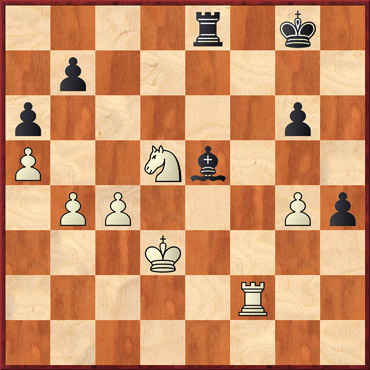
49.Nf4??
If White had wanted a draw, he might have
tried 49.Nf6+ Bxf6 50.Rxf6 where he is only
marginally worse, but the text allows Black
to exchange the rooks and improve his
chances. 49...Rf8! 50.Nh3 Definitely
not 50.Ke4?? Rxf4+ 51.Rxf4 Bxf4 52.Kxf4 g5+
53.Kf3 Kf7 with a clearly won king and pawn
endgame for Black. 50...Rxf2 51.Nxf2 Bg3!
And now it transpires it's
going to be a lot worse than just an
exchange of rooks. Black's
bishop will come to e1 and pick off a pawn.
If not two... 52.Nh3 52.Ne4 Be1 is
equally hopeless. 52...Be1 53.b5 Bxa5
54.Ke4 Kf7 55.Kd5 55.Nf4 Bd8 56.Nd3 a5
57.Nc5 h3 58.Kf3 Bc7 59.Na4 (59.Nxb7 a4 and
the pawn is too fast) 59...b6 60.c5 bxc5
61.Nxc5 Ke7 62.Na4 Bb8 also wins.
55...Bc7 56.Ng5+ Ke7 57.Nh3 Kd7 58.Ng5 Bf4
59.Nh3 Be3 60.Ke4 Bc1 61.Nf2 Ba3 62.Kf4 Bd6+
Black is going around the houses a bit
with his bishop but it doesn't
spoil the win. 63.Kf3 a5 Two passed
rook pawns, safe from capture, and a bishop
commanding operations from a central post:
it doesn't
get any better than this. 64.Nd3 b6 65.g5
a4 66.Kg4 a3 67.Nc1 Bg3 68.Nb3 Kd6 69.Kh3 a2
0‑1
White Rose 4-4 Wood
Green HK; Barbican 1 3-5 Guildford 2; The
ADs 3˝-4˝ Blackthorne Russia; South Wales
Dragons 5-2˝ Warwickshire Select
At least with the
Sunday matches, people don't have to worry
about travelling or getting to the board on
time. At least, assuming they've not been
overindulging in the bar too long on
Saturday night. Being a hundred miles away
at the time, I wouldn't know. Perhaps it's
just as well...
|
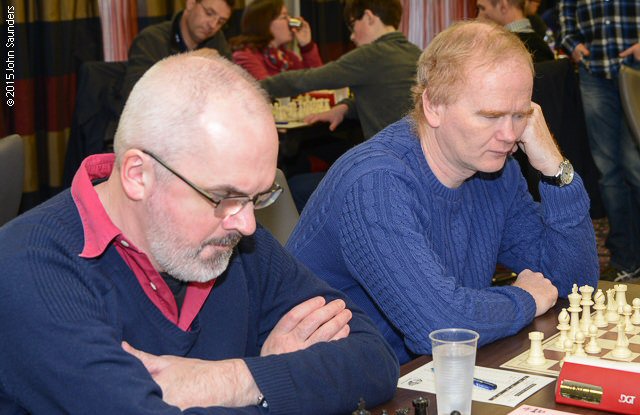 |
|
John Shaw and Neil McDonald (Wood
Green HK) |
Division 1a was all but
decided on the Saturday, at least as regards
which teams were destined for which final
pool. Wood Green could still technically
displace White Rose but only if they beat
them on the Sunday (feasible) and then see
them fail to win their final match next
month against Warwickshire (with all due
respect to the latter, much less feasible).
White Rose did their best to help the Wood
Green cause with a couple of Sunday horror
shows but it wasn't enough. Don't miss the
final couple of moves in the following game
– the finish is a collector's piece.
4NCL 2014/15, Division 1a, Round 6
Richard Palliser
(White Rose)
John
Shaw
(Wood Green HK)
1.e4 c5 2.Nf3 e6 3.Nc3 Nc6 4.d4 cxd4 5.Nxd4
Nf6 6.Be2 d6 7.Be3 Be7 8.0‑0
Bd7 9.f4 Nxd4 10.Qxd4 Bc6 11.b4
A move apparently first played by James
Tarjan in 1980. Curiously, the
aforementioned player has also made a
reappearance recently after some decades'
absence from the game. 11...b6 12.Bf3
0‑0
13.Rad1 Rc8 14.Bf2 Qc7 15.a3 Rfd8 16.Qe3 Bb7
Perhaps White was now regretting his overly
bold 11th move as it has noticeably weakened
the c-file.
17.Nb5 Qxc2 18.e5 Life gets difficult
after this. 18.Nxa7 Rc3 19.Rc1!? Rxe3
20.Rxc2 Rxa3 21.Nb5 Raa8 22.e5 is suggested
by Houdini. 18...Nd5 19.Bxd5 Bxd5 20.exd6
Bf8 21.Nxa7 It was a tough choice
between this and 21.Rc1 Qg6 22.Qg3 Rxc1
23.Rxc1 Qe4, which looks pretty good for
Black. 21...Rc3 22.Qxb6 The
alternative was to grovel with 22.Qe1 Rxa3
23.Nb5 Ra2 when 24.Nc3 may be answered by
24...Bb7! since 25.Nxa2?? allows mate with
25...Qc6, etc. 22...Rxd6 23.Qb8 Rd3
Houdini suggests 23...Qe4, forcing 24.Rxd5
Rxd5. Though this does not appear wholly
convincing to the human eye, the computer
thinks it's
game, set and match. 24.Rc1? This
meets with a scintillating refutation. The
alternative was 24.Rxd3! Qxd3 25.Re1 (To
cover Qe4) 25...Qg6 26.Bg3! when Black still
has work to do, e.g. 26...Rd7 27.Qb6 h5
28.f5! Qxf5 29.Qf2 Qg6 30.Nb5, etc.
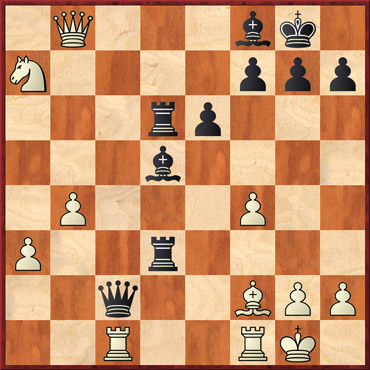
24...Rg3!!
Lawrence Cooper, with an eye to the g3
square, the location of a famous Frank
Marshall sacrifice back in 1912, asked if
the board was showered with gold coins after
this move. 25.hxg3 25.Rxc2 Rxg2+
26.Kh1 Rg3 mate. 25...Qe4
0‑1
White has a choice between being mated in
one move, or in 13 moves after 26.Qxf8+
-
I'll
leave readers to amuse themselves working
out how White can keep the game going that
long.
4NCL 2014/15, Division 1a, Round 6
Andrew Greet
(Wood Green)
Matthew
Webb
(White Rose)
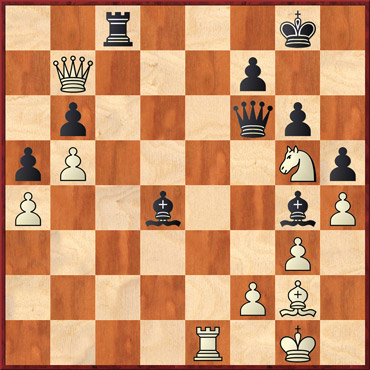
The advantage in this game had already gone
back and forth a couple of times -
and is going to do so twice more. 38.Bf3?
38.Kh2!? Bxf2 39.Rf1 remains balanced,
so the engine tells me. White has the threat
of 40.Ne4 forking quuen and bishop but it's
decidedly complex after 39...Rc2!?
38...Rc2! Now Black is in dire trouble.
39.Rf1 Ra2 40.Kg2 Qf5! Not
40...Rxa4?? when 41.Bd5! turns the tables.
41.Qc6 Bc5 42.Qa8+ Kg7 43.Qb7 Bxf3+
Black could have played 43...Rxa4! this time
if he had spotted that, after 44.Bd5 comes
44...Be2! and Black gets his retaliation in
first. But the text is pretty good too.
44.Qxf3 Qxf3+ 45.Kxf3 Ra3+? Best not to
chase the white king up the board, where it
finds a new purpose, and rather play
45...Rxa4 immediately. 46.Ke4 Rxa4+
47.Kd5 Rd4+ 48.Kc6 Rd6+ 49.Kc7 Rd2??
Disastrous, turning a likely win into a
loss: instead 49...Rd3 and Black can then
let the a-pawn
off the leash, with a probable win.
50.Ne4 Rb2 50...Rc2 51.Nxc5 Rxc5+
52.Kxb6 is worse. 51.Nxc5 Rxb5 52.Na4
1‑0
Black could play on but his long-term
chances of survival are minimal.
|
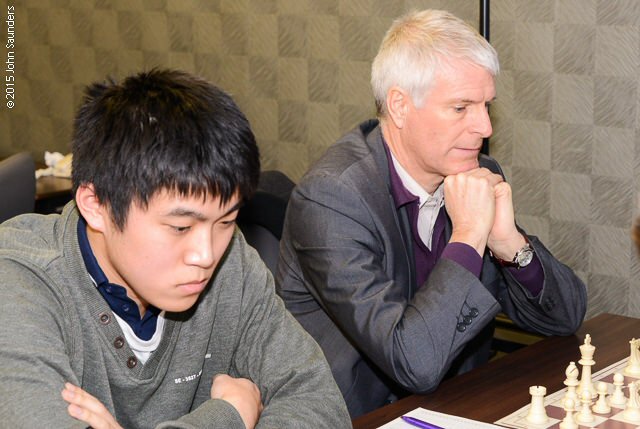 |
|
Yang-Fan Zhou, Glenn Flear
(Guildford 2) |
Guildford 2 vaulted
over Barbican 1 with their 5-3 win. Yang-Fan
Zhou's game against Matthew Turner revolved
round one long, forcing sequence which
seemed to span the passage from opening to
endgame.
4NCL 2014/15, Division 1a, Round 6
Yang-Fan Zhou
(Guildford 2)
Matthew
Turner
(Barbican 1)
1.e4 e5 2.Nf3 Nc6 3.d4 d6 4.Bb5 Bd7 5.0‑0
Nf6 6.Nc3
We've
transposed into an old-fashioned
Steinitz defence of the Ruy Lopez.
6...exd4 7.Nxd4 Be7 8.Re1
0‑0
9.a4 Re8 10.a5 Nxd4 11.Qxd4 Bxb5 12.Nxb5 d5
12...c6 seems more natural and then 13.Nc3
d5 14.e5 Nd7 15.Qg4, etc. 13.Bf4
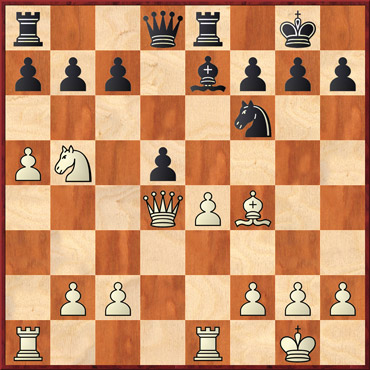
13...Nxe4?
This requires a lot of calculation and it
rather looks as if White saw further than
Black. 13...dxe4 looks safe enough for
Black, though his extra pawn won't
be worth much. 14.Nxc7 Bc5 15.Qxc5 Nxc5
16.Rxe8+ Qxe8 17.Nxe8 Rxe8 18.Be3! Black
has problems on the g1‑a7
diagonal. He can avoid material loss but not
a positional disadvantage. 18...Rc8
18...b6 19.b4 Nd7 20.Rd1 Re5 21.c4 leaves
Black with considerable problems. 19.Rd1
Na4 20.Rxd5 Nxb2 21.Rb5 Rxc2 Though it
means putting up with being a pawn down,
21...Nc4 is better, e.g. 22.Bxa7 f6 23.g4
Nd6 24.Rd5 Nc4 25.Kg2 Ne5 and it's
not over. 22.Rxb7 h5 23.Rxa7 Nd1 24.Bb6
Nxf2 25.h3 Not 25.Bxf2? Rc1+, regaining
the piece with a probable draw in prospect.
25...Ne4 26.Re7 Rc1+ 27.Kh2 Nd2?
After this Black is not going to be able to
give up his knight for the pawn. Instead
27...Nd6 28.a6 Nc8 29.Be3 Rc3 30.a7 Nxa7
31.Bxa7 and it looks like we could be headed
for the hungry arbiter's
nightmare -
a rook and bishop versus rook endgame.
28.a6 Nf1+ 29.Kg1 Ne3+ 30.Kf2 Nd5 31.Re8+
Kh7 32.Bd4! Nc7 32...Rc2+ 33.Kf3 Ra2
34.a7 Nc7 35.Rb8!, preparing Be3 and then
Rc8, to chase away the knight before
promoting the pawn in order to win the rook.
33.a7 Rd1 33...Rc2+ 34.Kf3 Rc4 35.Be3
Ra4 36.Rc8 wins. 34.Bb6 Nxe8 35.a8Q Nf6
36.Be3 Rd5 37.Qa4 Rf5+ 38.Ke2 Nd5 39.Bd2 g6
40.Qd4 f6 41.Qa7+ Kg8 42.Bh6 Re5+ 43.Kf2 Ne7
44.Qa2+ Rd5 45.Qa8+ Kf7 46.Qf8+ Ke6 47.Qe8
1‑0
The ADs suffered a
narrow defeat to Blackthorne Russia. Given
that the two teams were headed into
different final pools anyway, it was a dead
rubber. It consisted of seven draws plus a
win for Rita Atkins on bottom board against
Jana Bellin.
Warwickshire Select
lost again, by virtue of a default on bottom
board and a loss by Geoff Lawton on top
board, to James Cobb, in a position where he
was losing the exchange but not demonstrably
lost (at least, I didn't think so - if
you're interested, look it up). The result
will of course matter when it comes to the
relegation issue, where it doesn't need
Private Fraser to predict that the Midlands
side are probably ‘doomed, I tell ye',
whilst my former Welsh colleagues will be
glad of the two match points, and having
scored all four of their match points so far
against fellow strugglers (which means they
will be carried forward and count towards
their final pool tally).
Guildford 1 4˝-3˝
Cheddleton; Grantham Sharks 6-2 e2e4.org.uk;
Barbican 2 4-4 Cambridge University; Hackney
3˝-4˝ Oxford
Now we come to probably
the key match of the season so far:
Guildford 1 versus Cheddleton. At the start
of play the two teams were still on 100%
match points, although Guildford were way
ahead on game points. But it turned out to
be a very close match and could have gone
either way in several games, in particular
the only decisive game, where for a fleeting
moment Mark Hebden was at the mercy of Fiona
Steil-Antoni.
4NCL 2014/15, Division 1b, Round 6
Fiona Steil-Antoni
(Cheddleton)
Mark
Hebden
(Guildford 1)
1.e4 e5 2.Nf3 Nc6 3.Nc3 Nf6 4.g3 d5 5.exd5
Nxd5 6.Bg2 Nxc3 7.bxc3 Bc5 8.0‑0
0‑0
9.d3 Bb6 10.Re1
Simon Ansell played 10.Qe2 here against Mark
Hebden in 1997. 10...Qf6 11.Bd2 Re8
12.Qe2 h6 13.h3 Bd7 14.Nh2 Rad8 15.Ng4 Qg6
16.Kh2 h5 17.Be4? This intermezzo move
only helps Black to improve his position.
17.Ne3 is OK, though 17...Be6, followed by
...f7–f5 or ...h5–h4 gives Black the better
chances. 17...Qe6 18.Nh6+!? 18.Ne3
allows 18...Qxh3+ and the prospect of a
miserbale grind a pawn down, so White
decides to go all-in.
It's
not sound but it nearly paid off.
18...gxh6 19.Qxh5 Kg7 20.g4 Rh8 21.f4 Ne7?
Mark Hebden described this as “a
clanger”,
preferring 21...Be8 22.fxe5
Objectively, White still has insufficient
counterplay but it is difficult to get his
pieces organised. 22...Bc6 23.Bf5 Qd5
Understandably, the GM doesn't
fancy risking a pile of rating points on
23...Nxf5 24.gxf5 Qd5 25.Qg4+ Kh7 26.Bxh6!
which might be easy for a computer but is
too messy for a human to contemplate.
24.Be4
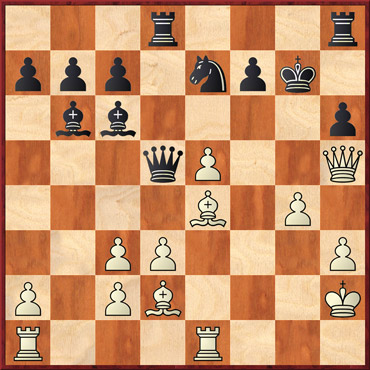
24...Qxe4?
Not sure which permutation of exclamation
marks and question marks to give to Black's
24th move. It worked well but the computer
finds a whopping big flaw in the analysis.
Instead 24...Qe6 and the game goes on.
25.dxe4? The refutation of Black's
faulty queen sacrifice lay in 25.Rxe4! Bxe4
followed up by 26.Qh4!. The point is that,
even though Black would then have rook and
two minor pieces for the queen, White's
various threats to recapture a minor piece,
invade on f6 and then h6 give her
overwhelming compensation. For example, if
26...Ng6 (26...Nc6 27.Qf6+ Kg8 28.Bxh6 Rxh6
29.Qxh6 Bg6 30.d4 is an easy win for White)
27.Qf6+ when either the d8 rook drops off or
White gives mate with Qxf7 if the king goes
to h7. As played, White's
all-important
bishop disappears and the Black pieces swarm
in to attack the king. A tragedy for White,
though the Rxe4/Qh4 idea is by no means a
simple pattern to identify, as exemplified
by the fact that so experienced a player as
Mark Hebden should have overlooked it.
25...Rxd2+ 26.Kh1 Ng6 Putting the queen
under close arrest. There is nothing to be
done. 27.Qf5 Rf2 28.Qh5 Rd8 29.g5 Rdd2
0‑1
|
 |
| Antoaneta
Stefanova (Guildford 1) |
Antoaneta Stefanova's
position looked shaky as she lost a pawn
coming up to the control, but her opponent
allowed her to win it back a few moves
later. Another Guildford player, Maxime
Lagarde, didn't look too comfortable against
Simon Williams, but it simplified down to a
drawn endgame. David Eggleston against
Jean-Pierre Le Roux was a highly eventful
draw, suddenly exploding into tactical
fireworks around move 19 but fizzling out to
a perpetual check only a handful of moves
later.
4NCL 2014/15, Division 1b, Round 6
David Eggleston
(Cheddleton)
Jean-Pierre
Le Roux
(Guildford 1)
1.e4 c6 2.d4 d5 3.Nc3 dxe4 4.Nxe4 Nf6
5.Nxf6+ gxf6
The Caro-Kann
line for players who like a walk on the wild
side. I think it might have been Julian
Hodgson who started playing this regularly
with a view to roughing up the opposition. I
can't
find any of his games on the database so
maybe that was only in weekenders. Or it's
my faulty memory. 6.c3 h5 Nigel Short
is another fan of this line. 7.Bc4 h4!?
A but unusual. 8.Qb3 e6 9.Nf3 Nd7 10.0‑0
If Black thought to put White off castling
kingside by thrusting his h-pawn
through to h4, his plan hasn't
worked. 10...Nb6 11.Be2 Qc7 12.c4 e5
13.dxe5 13.Qc2, to keep control of the b1‑h7
diagonal, or 13.Re1 also look pretty good
for White. King safety is a major issue for
Black. 13...fxe5 14.a4 h3 15.g3 Bg4
16.Bg5 Stopping queenside castling.
16.Re1 is again a very strong alternative,
e.g. 16...0‑0‑0
17.Nxe5!?, with a solid edge for White.
16...Rh5 17.Qe3 Nd7 18.Rad1 f6
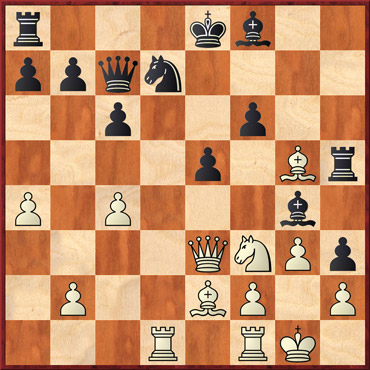
19.Rxd7!?
Pretty good but the computer finds the still
more powerful 19.Nxe5! Nxe5 20.Bxf6 Bxe2
21.Qxe2 Rf5 22.Rfe1! when 22...Rxf6 is
answered by 23.Qh5+ Qf7 24.Rxe5+ Be7 25.Qxh3
and the tactics favour White. 19...Qxd7
20.Nxe5? 20.Bxf6 still seems to favour
White. 20...fxe5 21.Qxe5+ Qe7! The
only try, and it's
very good: 21...Kf7 22.Qf4+ picks off the
bishop and should win; 21...Be7 22.Bxg4 is
hopeless. 22.Bxg4 Qxe5? This leads to
a very unusual and attractive perpetual
check pattern. Instead 22...Rxg5! 23.Bh5+
Kd7 24.Rd1+ Kc8 allows Black to escape the
checks and win with his extra material, e.g.
25.Qf4 Re5 26.Bg4+ Kb8 27.Bxh3 a5 28.Rd7
Qc5!,etc, when Black can eventually wriggle
his way out of the bind and win. 23.Bxh5+
Kd7 24.Bg4+ Ke8 24...Kd6 25.Bf4 Qxf4
26.gxf4 Kc5 probably doesn't
lose for Black but is certainly no way to
try for a win. 25.Bh5+ ˝‑˝
Matthew Sadler and Gawain
Jones both pressed for a win for a while
longer than others but by then the match
points were in the bag and there was little
incentive to go on. After winning this
match, Guildford 1 may feel they have at
least one hand on the championship trophy.
Perhaps only their own second team can now
give them a fright in the matches that
remain.
|
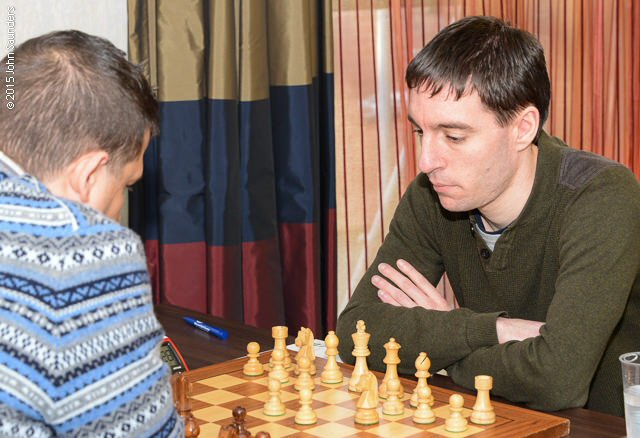 |
|
Ruben Cenal Gutierrez (Hackney) v
Tom Rendle (Grantham Sharks) |
Grantham Sharks aren't
yet mathematically sure of a place in the
Championship pool but they dipped a toe in
it by beating e2e4.org.uk. The following
game featured a tricky opposite-bishop
endgame.
4NCL 2014/15, Division 1b, Round 6
Thomas Rendle
(Grantham Sharks)
James
Jackson
(e2e4.org.uk)
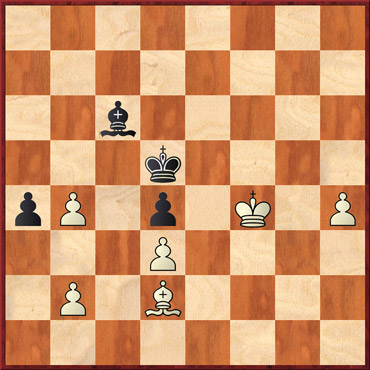
White is two pawns up but the bishop are of
opposite colours. A couple of moves before
Black had played ...b5–b4, sacrificing the
second of the two pawns, perhaps to allow
him to play ...Bb5 in order to tie the white
king to the defence of the d3–pawn. White
now has the choice of staying close to that
pawn, or simply to hurl the h-pawn
down the board in order to outmanoeuvre the
opposing king and win the d4–pawn.
48.Kf3? It's
logical in many ways, and White comes
tantalisingly close to a win, but it turns
out to be the wrong choice. Instead, 48.h5!
Bb5!? is the key position. (48...Ke6 49.h6
Kf6 50.h7 Kg7 51.Ke5 is a very simple win).
However, though it is far from obvious at
first sight, White can simply march up the
board with 49.Kf5! and take control of the
position. He still has to find a couple of
good moves, e.g. 49...Bxd3+ (The fact that
White's
move allows his opponent to capture with
check is perhaps one reason why it is hard
to see.) 50.Kf6 Kc4 51.h6 Be4 and now
52.Be1! is probably the clearest winner. The
d-pawn
can achieve nothing unsupported, while
52...Kb3 53.b5 Kxb2 54.b6 and the white pawn
is too quick. 48...Ke5+ 49.Ke2 Be8 50.Bh6
Kf5 51.Bg7 Kg4 52.Bxd4 Kxh4 53.Ke3 Kg4
54.Ke4 This plan seems pretty good too,
on the face of it, but it doesn't
quite get the job in the face of accurate
defence. 54...Bc6+! 55.Ke5 Bb5! 56.Bg1
Back-pedalling
with 56.Ke4 Bc6+ 57.Ke3 Kf5 doesn't
help as the black pieces can easily hold off
the two unconnected columns of pawns.
56...Bxd3 57.Kd4 Bf1 58.Kc5 Again, it
looks to be going well for White with the
black king seemingly too far away, but it's
an optical illusion. 58...Kf5 59.b5 Ke6
60.Kc6 Bg2+ 61.Kc7 Kd5! The king
switches direction towards the b2–pawn,
leaving the bishop to give itself up for the
b5–pawn. 62.b6 Kc4 63.b7 Bxb7 64.Kxb7 Kb3
65.Bd4 a3 66.bxa3 Kxa3 ˝‑˝
Barbican 2 drew their
match with Cambridge University. For
Barbican 2 that result means life in the
relegation pool, while for the Cantab team
it means they will have to overcome Grantham
Sharks in their final preliminary match if
they are to swim with the even more
dangerous predators of the Championship pool
come round eight.
|
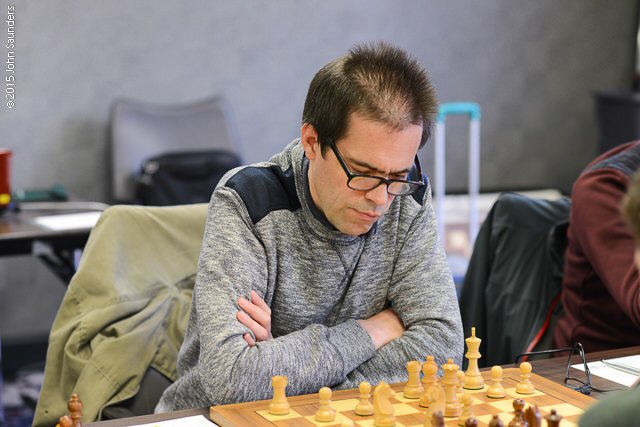 |
|
Bob Eames (Hackney) |
Meanwhile Oxford edged
Hackney by a single point. Oxford have been
the dark (blue) horses of this year's 4NCL
and deserve their place in the Championship
pool. Hackney are condemned to the
relegation pool. Did they miss any chances
in this match? Well, Michael Tasker did aim
Alekhine's gun at Ben Savage at one point
(you know that motif where a player lines up
two rooks along a file with a queen behind
them) but he turned out not to have any
ammo. Meanwhile Bob Eames had a torrid time
against Justin Tan.
4NCL 2014/15, Division 1b, Round 6
Bob Eames
(Hackney)
Justin
Tan
(Oxford)
1.e4 e5 2.d4 exd4 3.Nf3 Nc6 4.Nxd4
The Scotch Game. I wonder if this is a clue
to what the players were doing on the
previous evening. Pure speculation...
4...Bb4+ 5.c3 Bc5 6.Bc4 6.Be3 is more
frequently seen, and a bit more solid.
6...Nf6 7.Nxc6 bxc6 8.e5 Qe7 9.Qe2 Nd5
10.b4!? Bb6!
Provocative.
Black could reply 10...Nxb4!? since 11.cxb4
allows 11...Bd4 12.Bb2 Qxb4+ and a recapture
on b2. Perhaps White intended 11.0‑0!?,
giving up a pawn for development and
initiative. But Black doesn't
take the bait at all, settling for a healthy
set-up
on the queenside, with his bishops radiating
pressure along their diagonals. 11.a4 a5
12.b5 Bb7 13.0‑0
0‑0
14.Kh1
To be able to support the e5–pawn with f2–f4
in due course. Nevertheless, the king being
on the same diagonal as the b7 bishop could
prove to be uncomfortable later. 14...Kh8
15.Bd3 Qh4! Black steps up the pressure.
White's
lack of development on the queenside is
getting embarrassing. 16.f4 f6
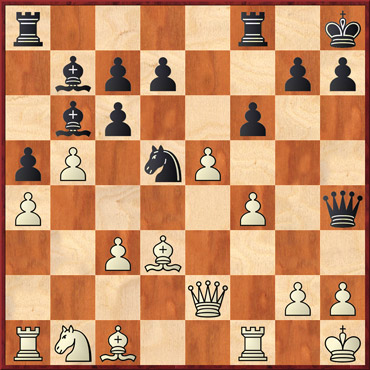
17.Rf3?
Really optimistic but White is struggling to
find a decent move. Maybe 17.c4 Nb4 18.Be4
but 18...fxe5 is hard to meet. 17...cxb5
18.Be4 When Black unfurled his long-diagonal
warhead, he was no doubt hoping for 18.Rh3??
Qxh3! 19.gxh3 Nxf4+ which is lethal. But
there is no need for anything fancy since
White is simply lost here. 18...fxe5!
19.g3 This time 19.Rh3 meets with
19...Nxf4! 20.Bxf4 Qxf4! 21.Nd2 (21.Rxh7+
Kg8 achieves nothing) 21...Bxe4 22.Nxe4 d5
and the three extra pawns will do the job.
19...Qh5 20.axb5 exf4 21.c4 Rae8 22.cxd5
Rxe4! 23.Rxf4 Rexf4 Simplest. Houdini
finds a more spectacular win -
23...Rf5 24.Qxh5 Bxd5!! -
but nobody would believe a human being
(ahem) unenhanced with silicon could find a
move like that. 24.Qxh5 R4f5 25.Qxf5 Rxf5
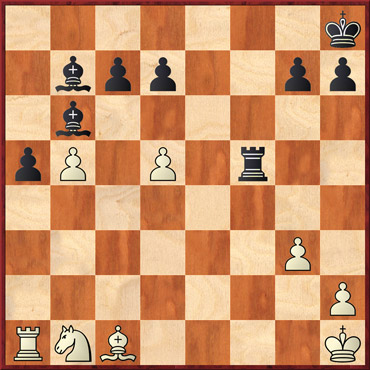
Resignation here, with the three queenside
pieces still on their original squares,
would have been more aesthetically pleasing
but also more embarrassing for White. Just
one more move, then... 26.Nc3 Rxd5
0‑1
Annotated games from the
above report |
Download
in PGN |
Player photos
(from weekend 2) ©
John Saunders
![]()
![]()
![]()